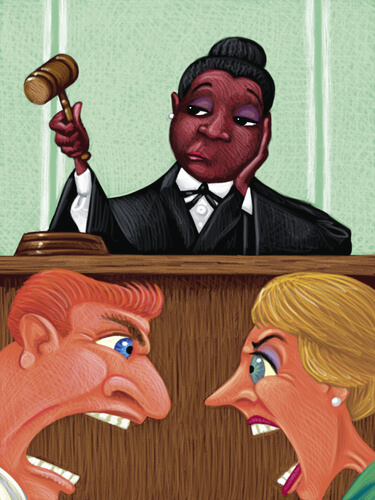
The Secret to Avoiding a Trial During Divorce
The court procedures in a family law case can seem intimidating to those who are unfamiliar to them.
An overview of the family law rules and process in Ontario will acquaint you with the new terminology and give you an idea of what you expect.
Remember, there are other options for resolving disputes over family law, besides going to court.
A divorce lawyer can help you decide on the best option in your particular case.
Parties to a divorce case are responsible for following the Family Law Rules, which cover every step in a case.
Preparing Court Documents
The person applying for the divorce is called the “Applicant,” and the other party is called the “Respondent.” As the first step, the Applicant prepares the Application for Divorce. This includes any claims for orders in relation to:
• Custody and access
• Child or spousal support
• Property division
If including claims involving financial matters, the Applicant must also complete a Financial Statement. This sets their income, expenses, assets and liabilities.
The application must be issued in a court that is either in a jurisdiction where one of the parties resides or the jurisdiction where the children reside.
Issuing, Serving and Filing Court Documents
The second step is for the Applicant to take the Application to a court clerk. They issues it by signing and dating it and applying the court seal to it. The clerk will also give the Applicant a court file number. All materials are then filed with the court.
The next step is to serve the Application, Financial Statement, and other necessary forms and documents on the Respondent. These materials must be served by a process called special service, which must be done by a person who is 18 or over and who is not the Applicant. This is usually effected through a process server.
Case Conference Date
The Applicant will also usually receive a case conference date at the time that the Application is issued. Case conferences are usually not heard for at least two or three months after the issuing of the Application. In a case conference, the parties and counsel meet with the judge and try to:
• Resolve any issues
• Make sure all of the necessary information has been provided
• Move the case forward to a trial or resolution.
Answer
Once the Respondent receives the Application, he or she has 30 days to serve and file any Answer, or 60 days if he or she lives outside of Canada. The Answer responds to the Application. It sets out which facts and claims the parties agree upon and which are in dispute. The Respondent may also set out any claims of his or her own in the Answer. Once the Answer is served on the Applicant, it is filed with the court. If there is no Answer, the divorce will proceed through court as uncontested.
Reply
The Applicant may disagree with some of the facts set out by the Respondent in his or her Answer or may need to respond to the claims set out in it. If so, the Applicant may draft a Reply to the Answer. The Reply must be served on the Respondent and filed with the court within 10 days of the Applicant’s receipt of the Answer.
Case Conference
The case conference is a mandatory step in all family law proceedings. It is an informal meeting between the parties, counsel and judge. Each party gets a chance to make submissions to the judge based on their idea of the case. Prior to the conference, the parties draft, serve and file Case Conference Briefs. These briefs consist of a summary of the issues in the case and the facts that support the party’s position.
The judge reviews the parties’ briefs and may give his or her opinion of the issues in the case. The judge’s assistance in discussing these issues may help the parties resolve their disputes. Or it may give insight into how the court will make decisions about these matters. If all issues cannot be resolved in a case conference, there may also be a settlement conference.
Motions
After the case conference parties are able to bring motions for the purpose of setting out arrangements to be followed until a final decision is made. Motions are usually based on Affidavit evidence. An Affidavit is a written document in which you set out the information or evidence the judge needs to make a decision. You must swear or affirm that the information is true and sign in front of a commissioner for taking Affidavits.
The parties serve their competing Affidavits and other materials and file them with the court. They then have a formal meeting before a judge with the purpose of obtaining a temporary court Order. The Order may deal with such claims as:
• Child or spousal support
• Custody and access
• Disclosure issues and property
If the matter is urgent a judge may hear a motion before a case conference.
Trial
If the parties cannot resolve their issues, they will appear in court for a trial.
At the trial they will present information and evidence in support of their position. They also have an opportunity to bring witnesses to court. Based on the information and evidence presented, the judge will make a final decision that will be set out in a judgment.
If you have any questions regarding the trial process and divorce law, our Toronto Family Law Lawyers are here to help you.
